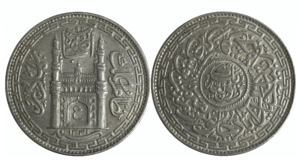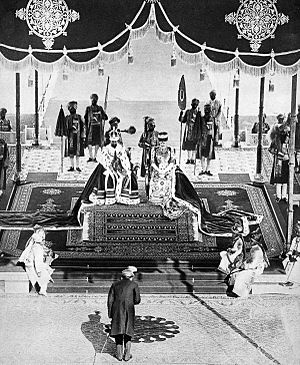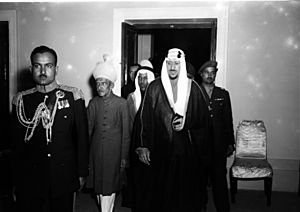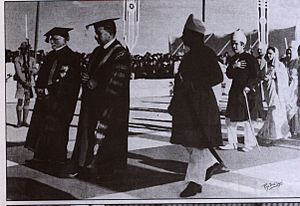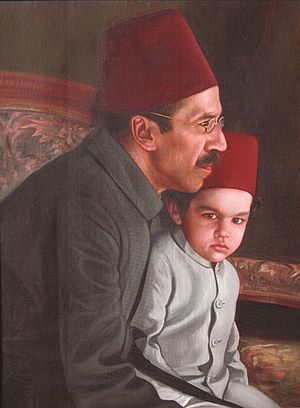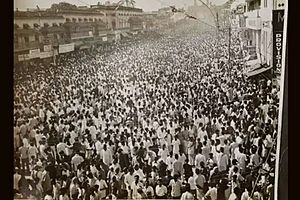Mir Osman Ali Khan facts for kids
Quick facts for kids Osman Ali Khan |
|
|---|---|
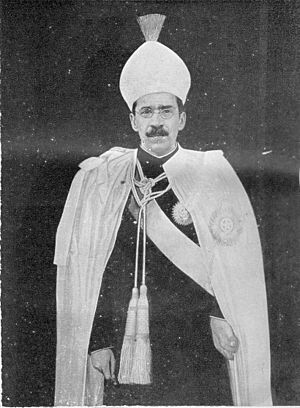 |
|
| 7th Nizam of Hyderabad | |
| Reign | 29 August 1911 – 17 September 1948 Titular: 17 September 1948 – 24 February 1967 |
| Coronation | 18 September 1911 |
| Predecessor | Mahbub Ali Khan, Asaf Jah VI |
| Successor | Barkat Ali Khan, Asaf Jah VIII (titular) |
| Prime minister |
See list
Kishen Pershad
Salar Jung III Sayyid Ali Imam Faridoon-ul-Mulk Wali-ud-Daula< Akbar Hydari Nawab of Chhatari Mirza Muhammad Ismail Nawab of Chhatari Mir Laiq Ali |
| Born | 6 April 1886 Purani Haveli, Hyderabad, Hyderabad State, British Indian Empire (now in Telangana, India) |
| Died | 24 February 1967 (age 80) King Kothi Palace, Hyderabad, Andhra Pradesh, India (now in Telangana, India) |
| Burial | Judi Mosque, (opposite King Kothi Palace), Hyderabad, Andhra Pradesh, India (now in Telangana, India) |
| Spouse | Dulhan Pasha Begum and others |
| Issue | See below |
| Urdu | نواب میر عثمان علی خان |
| House | Asaf Jahi dynasty |
| Father | Mahbub Ali Khan, Asaf Jah VI |
| Mother | Amat-uz-Zahrunnisa Begum |
Mir Osman Ali Khan, Asaf Jah VII (born April 6, 1886 – died February 24, 1967) was the last ruler, or Nizam, of the Princely State of Hyderabad. This was the largest princely state in British India. He became ruler on August 29, 1911, when he was 25 years old. He ruled the Kingdom of Hyderabad until 1948, when India took control of it. He was known as His Exalted Highness (H.E.H.) the Nizam of Hyderabad. He was also one of the richest people in history. In 1937, Time magazine called him the world's richest person.
He is often called the "Architect of modern Hyderabad." He helped create many important public places in Hyderabad city. These include Osmania University, Osmania General Hospital, State Bank of Hyderabad, Begumpet Airport, and the Hyderabad High Court. He also had two large lakes, Osman Sagar and Himayat Sagar, built during his rule. These lakes helped prevent big floods in the city, like the one in 1908.
The Nizam first wanted Hyderabad to join India. But after India became independent in 1947, he wanted his state to remain separate. His power was getting weaker because of a rebellion and a group called the Razakars. In 1948, the Indian Army took over Hyderabad State, and the Nizam had to give up his rule. After this, he became the Rajpramukh (a kind of governor) of Hyderabad State from 1950 to 1956. Later, the state was divided and became parts of Andhra Pradesh, Karnataka, and Maharashtra.
In 1951, he helped start the Nizam Orthopedic hospital, which is now Nizams Institute of Medical Sciences (NIMS). He gave it to the government for a very low rent. He also gave away a lot of his personal land to a movement called Bhoodan movement. This land was then given to farmers who didn't own any land.
Contents
Early Life and Education
Mir Osman Ali Khan was born on April 6, 1886. He was the second son of Mahbub Ali Khan, Asaf Jah VI. He was born at Purani Haveli palace. He was taught at home and learned to speak Urdu, Persian, Arabic, and English very well. He also received training in court manners and military skills.
When he was young, a British tutor named Sir Brian Egerton taught him English. During this time, he lived away from the main palace. This helped him grow into a well-mannered gentleman. Sir Egerton said that young Mir Osman Ali Khan was generous and eager to learn.
Becoming the Ruler
Mir Mahboob Ali Khan, the previous Nizam, died on August 29, 1911. On the same day, Mir Osman Ali Khan was declared the new Nizam (Nizam VII). His official crowning ceremony happened on September 18, 1911, at Chowmahalla Palace. Important people from Hyderabad and British officials attended this event.
The famous Golconda mines were a big source of wealth for the Nizams. In the 1700s, the Kingdom of Hyderabad was the only place in the world that supplied diamonds.
Hyderabad was the largest princely state in India before it became independent. It was about the size of the United Kingdom today. The Nizam was the most important prince in India. He was one of only five princes who received a special 21-gun salute. He also had the unique title of "Nizam" and was called "His Exalted Highness." The British also called him the "Faithful Ally of the British Crown."
First Years of Rule (1911 to 1918)
In 1908, before the Nizam became ruler, a huge flood hit Hyderabad city. Thousands of people died. To prevent future floods, the Nizam ordered the building of two large lakes. These lakes were named Osman Sagar and Himayat Sagar.
He was given the title "Faithful Ally of the British Crown" after World War One. This was because he gave a lot of money to help the British Empire during the war. For example, he paid for many airplanes for the British Air Force. He also paid for a Royal Navy ship, the HMAS Nizam.
In 1918, the Nizam created Osmania University. This was the first university where Urdu was the main language for teaching. The university's main campus was finished in 1934.
Later Years (1918 to 1939)
In 1919, the Nizam set up the Executive Council of Hyderabad. This council helped him govern the state. It had a president, who was also the prime minister, and eight other members. Each member was in charge of different government departments.
The Begumpet Airport was built in the 1930s. The Nizam started the Hyderabad Aero Club which led to its creation. His airline, Deccan Airways Limited, which was one of the first in British India, used it for flights. The airport terminal building was completed in 1937.
End of His Reign (1939 to 1948)
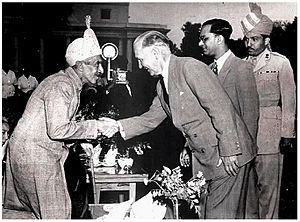

The Nizam arranged for his first son, Azam Jah, to marry Princess Durrushehvar. She was the daughter of the last Ottoman Caliph, Abdulmejid II. After India became independent, the Nizam wanted Hyderabad to be an independent country. However, his power was weakening. There was a rebellion called the Telangana Rebellion. Also, a group called the Razakars wanted Hyderabad to stay under Muslim rule.
In 1948, India launched Operation Polo and took over Hyderabad State. This ended the Nizam's rule. He then became the Rajpramukh (governor) of Hyderabad State from 1950 to 1956.
Contributions to Society
The Nizam made many important contributions to society, especially in education and public works.
Improving Education
He spent a lot of his government's money, up to 11% of his budget, on education. He gave large donations to many schools and colleges in India and even abroad. He especially supported places like the Jamia Nizamia and the Darul Uloom Deoband.
He founded Osmania University in 1918. It is now one of the biggest universities in India. He also set up many schools, colleges, and a special department for translating books. Primary education was made mandatory and free for poor children.
He also gave money to other universities. He donated Rs 1 million to the Banaras Hindu University and Rs 500,000 to the Aligarh Muslim University. He also gave Rs 300,000 to the Indian Institute of Science.
Building Public Places
Many important public buildings in Hyderabad city were built during his time. These include the Hyderabad High Court, Jubilee Hall, Nizamia Observatory, Moazzam Jahi Market, Kachiguda Railway Station, and the State Central Library, Hyderabad. He also built hospitals like Osmania General Hospital and Nizamia Hospital. The Hyderabad House in Delhi, now used for important government meetings, was also built by him.
Starting the Hyderabad State Bank
In 1941, the Nizam started his own bank, the Hyderabad State Bank. It was later called State Bank of Hyderabad. This bank managed the Osmania Sikka, which was Hyderabad's own money. Hyderabad was the only state in British India that had its own currency. In 2017, the State Bank of Hyderabad joined with the State Bank of India.
Preventing Floods
After a terrible flood in 1908, which killed many people, the Nizam built two large lakes. These lakes, Osman Sagar and Himayat Sagar, were built to stop future floods. They were named after himself and his son.
Helping Agriculture
The Nizam also helped farming. He started agricultural research in the Marathwada region of Hyderabad State in 1918. During his rule, there were crop research centers for important crops like sorghum, cotton, and fruits.
Supporting Indian Aviation
India's first airport, the Begumpet Airport, was started in the 1930s. This happened when the Nizam formed the Hyderabad Aero Club. His airline, Deccan Airways Limited, was the first airline in British India and used this airport.
Donations to Hindu Temples
The Nizam also gave money to Hindu temples. He donated Rs 82,825 to the Yadagirigutta temple, Rs 29,999 to the Sita Ramachandraswamy temple, Bhadrachalam, and Rs 8,000 to the Tirupati Balaji Temple.
He also gave Rs 50,000 to help rebuild the Sitarambagh temple in Hyderabad. He also gave a large amount of money, 100,000 Hyderabadi rupees, to rebuild the Thousand Pillar Temple. He also provided yearly grants to the Golden Temple of Amritsar.
Helping with the Mahabharata
In 1932, money was needed to publish the holy Mahabharata by the Bhandarkar Oriental Research Institute in Pune. Mir Osman Ali Khan gave Rs 1,000 each year for 11 years to help with this. He also gave Rs 50,000 to build a guest house for the institute, which is still called the Nizam Guest House today.
Contribution to National Defence Fund
In 1965, during an economic crisis, the Nizam invested 425 kilograms of gold in India's National Defence Gold Scheme. This helped India during a difficult time.
Wealth and Jewels
The Nizam was incredibly wealthy. Time magazine featured him on its cover in 1937, calling him the world's richest man. He owned many valuable things, including the Jacob Diamond. This huge 185-carat diamond was so common to him that he used it as a paperweight!
The Indian government now displays many of his jewels as the Jewels of the Nizams of Hyderabad. This collection has 173 jewels. It includes many emeralds and thousands of pearls. The collection has gemstones, turban ornaments, necklaces, pendants, belts, earrings, armbands, bangles, bracelets, anklets, cufflinks, buttons, watch chains, and rings.
Gift to Queen Elizabeth II
In 1947, the Nizam gave a special gift of diamond jewels to Queen Elizabeth II for her wedding. This gift included a tiara and a necklace. The Queen still wears parts of this gift, and the necklace is known as the Nizam of Hyderabad necklace.
Personal Life
The Nizam lived at King Kothi Palace from the age of 13 until he died. He was not very interested in fancy clothes or hunting, unlike his father. He enjoyed poetry and writing Urdu ghazals.
He deeply respected his mother. He visited her every day when she was alive. After she passed away, he would visit her grave almost every day.
Family
At 21, on April 14, 1906, he married Azam Unnisa Begum. His first son, Azam Jah, married Durru Shehvar, the daughter of the last Ottoman Caliph. His second son, Moazzam Jah, married Princess Niloufer, a niece of the Ottoman sultan. The Nizam had 34 children in total: 18 sons and 16 daughters. His grandson, Mukarram Jah, became his official heir.
Final Years and Death
The Nizam stayed at the King Kothi Palace until he died on Friday, February 24, 1967. In his will, he asked to be buried in the Masjid-e Judi mosque, where his mother was also buried.
The government announced a day of mourning on February 25, 1967, the day he was buried. Government offices were closed, and the National Flag of India was flown at half-mast. Many people came to his funeral. It was one of the largest non-religious gatherings in India's history at that time. Millions of people from all over the state came to Hyderabad to see their former ruler one last time. The crowd was so large that special barriers were put up to help people move in lines. It is estimated that about one million people were part of the procession.
Titles and Honors
The Nizam was given many special titles and honors during his life. In 1918, King George V changed his title from "His Highness" to "His Exalted Highness". He was also given the title "Faithful Ally of the British Government."
Honors and Awards
- Delhi Durbar Gold Medal (1911)
- Knight Grand Commander of the Order of the Star of India (1911)
- Bailiff Grand Cross of the Order of St John (1911)
- Knight Grand Cross of the Order of the British Empire (1917)
- King George V Silver Jubilee Medal (1935)
- King George VI Coronation Medal (1937)
- Royal Victorian Chain (1946)
Things Named After Him
- Osmania General Hospital
- Osmania Biscuit
- Osman Sagar, a lake in Hyderabad
- Osmanabad, a city
- The Nizam of Hyderabad necklace
- The Nizam Gate, at Ajmer Sharif Dargah
Images for kids
-
The Nizam with the then Prime minister of India Lal Bahadur Shastri
See also
 In Spanish: Asaf Jah VII para niños
In Spanish: Asaf Jah VII para niños



